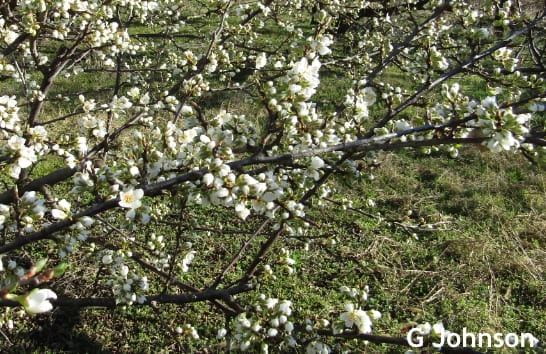Gordon Johnson, Extension Vegetable & Fruit Specialist; gcjohn@udel.edu
There were several advective freeze events this past week when freezing temperatures occurred along with high winds. Lows for the early morning on March 29 ranged from 22-26 °F and wind gusts over the period were over 30 mph. Cold damage in stone fruits is of concern because many trees are flowering, two weeks ahead of normal.
Stone Fruits
Stone fruits (peaches, nectarines, plums, and apricots) are currently in various stages of flowering from first color to past bloom. Research has shown that when stone fruits are in the First Pink (first color) stage (flower petals coming out of bud but not open), the temperatures required to cause 10% and 90% kill at this bud development stage were 25°F and 15°F, respectively. At First Bloom, the temperatures required to cause 10% and 90% kill were 26°F and 21°F, respectively. At Full Bloom Stage the temperatures required to cause 10% and 90% kill were 27°F and 24°F, respectively and at Post Bloom Stage the temperatures required to cause 10% and 90% kill were 28°F and 25°F, respectively. We will not know the full extent of the damage for several weeks until fruit drop occurs.

Over 50% of open plum flowers will have been killed by the recent advective freezes

Nectarine blooms in first pink stage may have had minor losses (10%)
Strawberries
Fortunately, plasticulture strawberries were still under row covers that will, depending on weight, protect down to 24°F. For strawberries the critical temperature during bloom at the blossom level is 28°F. Below 28°F, there is a progressively higher risk of flower damage, and below 26°F most blooms will be damaged or killed. Flowers that are not open and just emerging from the crown can tolerate temperatures down to 22°F and once fruit has formed temperatures down to 26°F can be tolerated for short periods of time. Flower acclimation is also important. Plants with flowers exposed to several cold days before a freeze will be more tolerant than those exposed to warm days before. For strawberries, two layers of floating row covers may be the most effective strategy for advective freezes. Double covers have been shown to be more effective than single heavy covers in this case.
